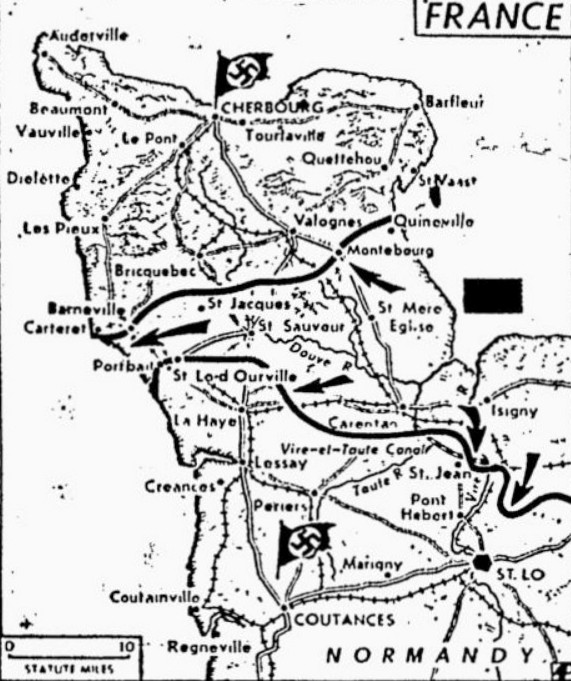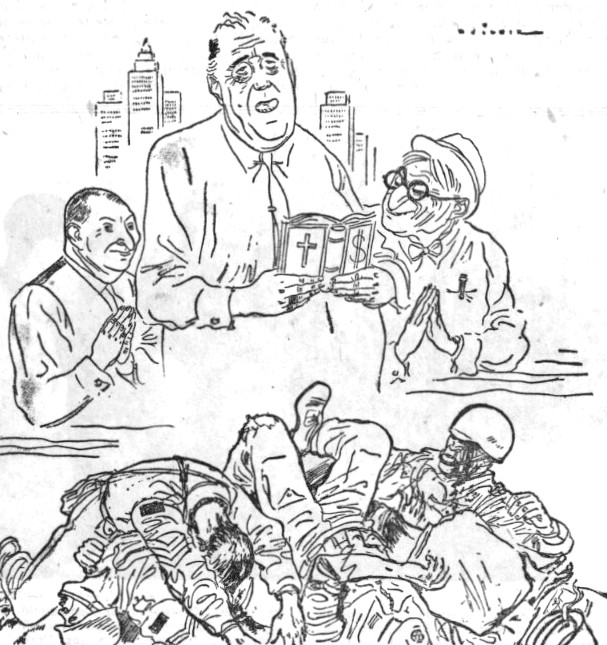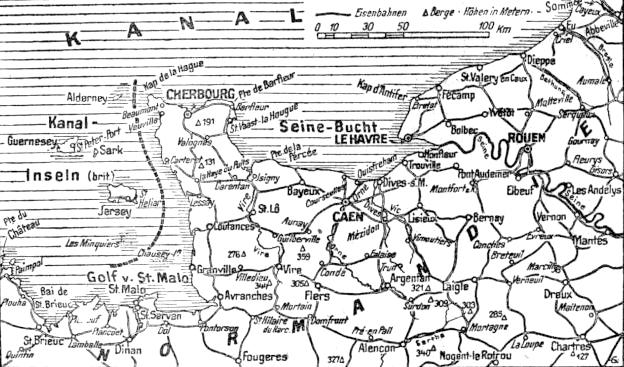The Free Lance-Star (June 20, 1944)
CAPTURE OF CHERBOURG BY YANKS IMMINENT
9th Infantry Division now only four miles from port city
Germans fall back on city’s defenses
Where Yanks close trap on Germans
Arrows indicate U.S. advances including the breakthrough to the west coast of the Cherbourg Peninsula between Barneville and Saint-Lô-d’Ourville, thereby trapping thousands of Germans to the north. The principal other U.S. gain was a drive east of Vire River to within less than six miles of Saint-Lô.
Bulletin
New York (AP) –
Troops of the 9th Infantry Division have captured Saint-Martin-le-Gréard, four miles from Cherbourg, the London radio said today in an NBC-recorded broadcast.
SHAEF, London, England (AP) –‘
U.S. troops plunged within four miles of Cherbourg late today in an all-out offensive of mounting fury, and also seized Valognes, 10 miles southeast of the great harbor.
The veteran U.S. 9th Infantry Division spearheaded the deepest drive directly south of Cherbourg – a death pocket for perhaps up to 50,000 Nazis – advancing to Saint-Martin-le-Gréard only four miles away.
On the southeast approach to the transatlantic port, other doughboys seized Valognes and pushed a mile beyond, and cleaned the Germans out of bypassed Montebourg, four miles from Valognes.
The Germans were falling back upon the inner perimeter of Cherbourg’s defenses, Associated Press correspondent Roger Greene said in a dispatch from U.S. field headquarters. He added the Germans fell back from Valognes “without attempting a major stand.”
The power drive directly south of Cherbourg carried the 9th Infantry Division battering ram nearly six miles north of captured Bricquebec.
On the eastern coast of the trap tightening steadily on Cherbourg, a U.S. column drive two miles north of Quinéville.
Montebourg, won and lost by the Yanks in bitter street fighting and then bypassed in the push to Valognes, has now been completely occupied, Supreme Headquarters said.
Repulse counterattacks
Toward the eastern flank of the long Normandy front, British forces battling against a wall of Nazi armor struck two miles southwest of Tilly-sur-Seulles and seized Hottot-les-Bagues. Two Nazi counterattacks aimed at retaking the town were beaten back.
U.S. forces on the west coast also made progress north of Barneville, where the first breakthrough was made sealing off the top of Cherbourg Peninsula. Opposition in this sector was reported light.
The Germans have three semi-circular defense lines around Cherbourg, with the biggest stretching out six miles from the port. Lt. Gen. Omar N. Bradley’s offensive has pierced deep through this line and has apparently reached the second defense wall.
Air reconnaissance disclosed the Germans have been demolishing the port of Cherbourg and that it is in bad shape, indicating they had given up hope of holding it for very long.
There were indications the Germans were weaker on the western side of the peninsula than in the east.
Heavy aerial blows
The all-out Cherbourg drive was coupled with what happened to be the greatest air effort since the first days of the invasion, and more than 1,500 U.S. heavy bombers bombed targets in Germany and the rocket bomb platforms in the Pas-de-Calais area on the French coast.
Drawing new strength from other sectors of the Normandy beachhead, Lt. Gen. Omar N. Bradley sent his troops surging northward in what Supreme Headquarters called “coordinated attacks along the entire north front.”
Over the heads of the advancing doughboys, American big guns hurled streams of shells into the great port (France’s third largest), defended by possible 50,000 German troops now caught in the closing Yankee trap.
The deepest wedge was driven into the German ring of fortifications from the southwest. A column sweeping forward from captured Bricquebec, 11 miles below the port, hurled the Germans back to the outskirts of Rauville-la-Bigot, a village between six and seven miles south and slightly west of Cherbourg.
Communiqué No. 29 from Gen. Dwight D. Eisenhower’s headquarters said other U.S. columns to the east were driving forward in twin moves to flak Valognes, ten miles southeast of Cherbourg, after sweeping around Montebourg and cutting off isolated pockets of Germans there.
Wedge widened
The American wedge across the Cherbourg Peninsula is now 16 miles at its widest point and eight miles at its narrowest. Expanding to the north, Gen. Bradley’s Yankees are now racing rapidly toward the main German defense line six miles south of the port.
It was expected that a matter of hours would show the strength of these defenses and whether the Germans can manage to swing the muzzles of the port’s long-range guns from the sea to repel a land attack.
The German-held Channel Islands have guns capable of shooting to the Cherbourg Peninsula at extreme range, but headquarters said there is no reason to believe “they can seriously interfere with the American advance.”
German troops all along the north front were reported apparently badly disorganized. Front dispatches declared many of the high Nazi officers had been killed and, in some sectors, units had been cut to pieces.
No gains were reported in the Carentan area to the south and it seemed apparent that Bradley was content merely with holding actions there while driving all-out for Cherbourg.
The building up of the beachhead forces and supplies was hampered yesterday, however, by a wind of 25 miles an hour which whipped up five-foot waves along the beaches. A 60-mph gale swept the Channel.




